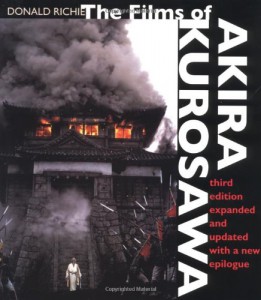The Films of Akira Kurosawa


Moyenne des votes : ![]()
| 0 | vote | |
| 0 | vote | |
| 0 | vote | |
| 0 | vote |
Votre vote : -
Description de l'ouvrage:
In an epilogue provided for his incomparable study of Akira Kurosawa (1910-1998), Donald Richie reflects on Kurosawa's life work of thirty feature films and describes his last, unfinished project, a film set in the Edo period to be called The Ocean Was Watching.
Kurosawa remains unchallenged as one of the century's greatest film directors. Through his long and distinguished career he managed, like very few others in the teeth of a huge and relentless industry, to elevate each of his films to a distinctive level of art. His Rashomon—one of the best-remembered and most talked-of films in any language—was a revelation when it appeared in 1950 and did much to bring Japanese cinema to the world's attention. Kurosawa's films display an extraordinary breadth and an astonishing strength, from the philosophic and sexual complexity of Rashomon to the moral dedication of Ikiru, from the naked violence of Seven Samurai to the savage comedy of Yojimbo, from the terror-filled feudalism of Throne of Blood to the piercing wit of Sanjuro.
Revue de Presse:
"A gratifying study for both film buff and critic."
— Kirkus Reviews
"The seminal work on one of the greatest of all film artists, [it] has universally been regarded as a masterpiece of film criticism."
— Bloomsbury Review
"Definitive, readable, and a virtual model for future studies in the field."
— Saturday Review
From Library Journal:
This third edition of a work first published in 1965 covers the four films made since the second edition was released, including Ran, arguably Kurosawa's biggest hit in America. Kurosawa is acknowledged as one of the greatest artists of the sound era, and he is easily the best-known Japanese director to Western audiences. This book concentrates solely on the films themselves; other than a brief biographical section that ends when Kurosawa began directing and a closing analysis of his style and methods, no additional topic is covered. Each film is analyzed separately along the lines of characterization, story, camera, production, music, treatment, and so forth. Greater space is given to the masterpieces: Rashomon, Seven Samurai, Ikiru, and The Throne of Blood. Richie's expertise is hard to miss; surely he overlooks no aspect of these films. Given Kurosawa's age (he's 86) and the difficulties of financing in Japanese cinema, it is unlikely he will produce any more movies. Highly recommended for academic and film collections; public libraries should buy according to demand.?Marianne Cawley, Enoch Pratt Free Lib., BaltimoreCopyright 1996 Reed Business Information, Inc.
Voir le site internet de l'éditeur University of California Press
Voir la filmographie complète de Akira Kurosawa sur le site IMDB ...
> Du même auteur :
> Sur un thème proche :
The Russian Kurosawa (2023)
Transnational Cinema, or the Art of Speaking Differently
Sujet : Director > Akira Kurosawa
Kurosawa, Shakespeare and Others (2023)
Art and the Human Experience
de Anne-Marie Costantini-Cornède
Sujet : Director > Akira Kurosawa